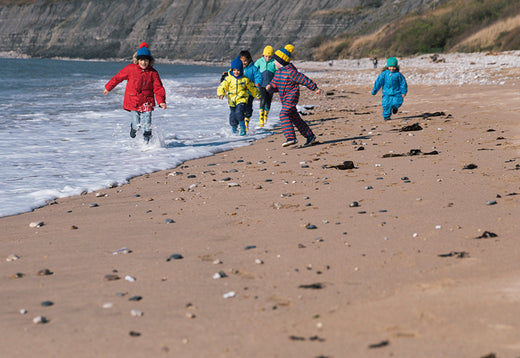
Why Kids Spend Less Time Outdoors Than Prisoners
Did you know that, on average, children around the world spend less time outdoors than a maximum-security prisoner? And that more than one in nine children in England have not been to a park, forest, beach or any other natural environment for at least 12 months? Quite shocking, isn’t it?
What happened to children’s right to roam? We’ve rounded up 5 possible reasons children spend less time outdoors than prison inmates and a couple of brilliant tips on how to reverse this negative trend.
As a brand, we aim to spread the message that children need to spend as much time outdoors as possible (ideally 5-15 hours a week or more) to develop healthy bodies and minds. We believe that playing and learning outdoors is the best thing children can do to become happy and healthy adults. When we look back, it becomes clear that the generations of our grandparents, parents and even our own spent way more time outdoors than the children nowadays. There are many reasons for that: smartphones and all the modern technology simply didn’t exist, and children had no choice but to head outdoors to have some fun. This is where friendships were made and where we grew up and discovered the world. We did some research and had a long discussion here at the Muddy HQ and found 5 reasons why children spend less time outdoors than ever. However, we realised that the world is not as dangerous as we might think and that we should encourage more young explorers to head outside as often as they can.
1) Road safety issues
We know that road accidents are one of the main reason why parents are reluctant to let their children roam free. However, the number of children killed in road accidents has steadily declined for many years. Britain is also one of the countries with the lowest road traffic death rate in the world and keeping children safe on the road is an ongoing priority. Brilliant charities such as Brake promote safe road use and organise lots of events for school, pre-schools and local communities. Companies such as THB (national road surfacing contractor) are not staying behind – THB have put in place the fantastic “Safe steps for schools” programme. They install fun and colourful road crossings to teach children road safety. While teaching our brave explorers to be cautious while walking or cycling is crucial, statistics are showing that roads are safer now than when we were children ourselves.
2) Stranger danger
Who hasn’t heard “don’t talk to strangers!” at least once in their life? It’s still a valid point and nothing is more important than protecting our little ones from danger. On the positive side, we believe that the issue of child safety is taken very seriously by the public services and, of course, by parents. There are countless articles online on how to protect children from potentially dangerous strangers and lots of tips or videos for children.
3) Modern technology
It’s easy, if not too easy, to entertain children indoors. 1 in 4 children under 6 own a smartphone nowadays and spend more than 20 hours a week on it. No wonder why NDD, or “Nature Deficit Disorder” is now a recognised medical condition. Sounds familiar? Although we cannot ban smartphones and laptops from our homes, we can make sure our children’s screen time is balanced with outdoor activities. We can even include technology in outdoor play to encourage children to spend more time outside. There are lots of tools to be used outdoors such as stargazing applications (we tried Star Walk 2 and we loved it!) or animal-tracking applications.
4) Lack of local outdoor spaces
Not enough outdoor spaces to play is another reason why children stopped playing outside. With 83% of us living in urban areas it’s not always easy to find a safe place where our children can run free and wild. However, cities are making efforts to build new play spaces where the little ones can discover the world and learn through play. There are outdoor play spaces in pretty much every bigger park in London. Recently, The New York Times praised British playgrounds for being much more adventurous than those in the US and “bringing risk to build resilience”. Although we envy those who grow up in the countryside and roam freely, we believe that cities have a lot to offer as well.
5) Commuting to school
How many children walk or bike to school instead of coming by car? The answer is “not enough”. It’s often easier to drive or use the public transport but some physical activity in the morning or in the afternoon is great for their health at well-being (doctors recommend at least 60 minutes of physical activity a day). According to research, only one in four school pupils are allowed to walk home alone from school and 94% of British primary schoolchildren are escorted to school every day. So what can we do to reverse this trend? Simply get outdoors as often as possible! There are so many ways to spend a wonderful day outside with your little adventurers, so many walking games to play and so many reasons to enjoy fresh air and nature. Our tips:
- Start small - as little as one hour spent outdoors every day can benefit your family’s health
- Come up with fun outdoor activities
- Involve the whole family
- Choose the right kit to keep your children warm and happy whatever the weather
Muddy Puddles feel passionate about children’s right to roam being and their freedom to play and explore outside. We love rounding up guides and tips to encourage your children to get outdoors. Have a look at the top 10 family-friendly walks in the UK, get your children into gardening or organise a brilliant family scavenger hunt.








